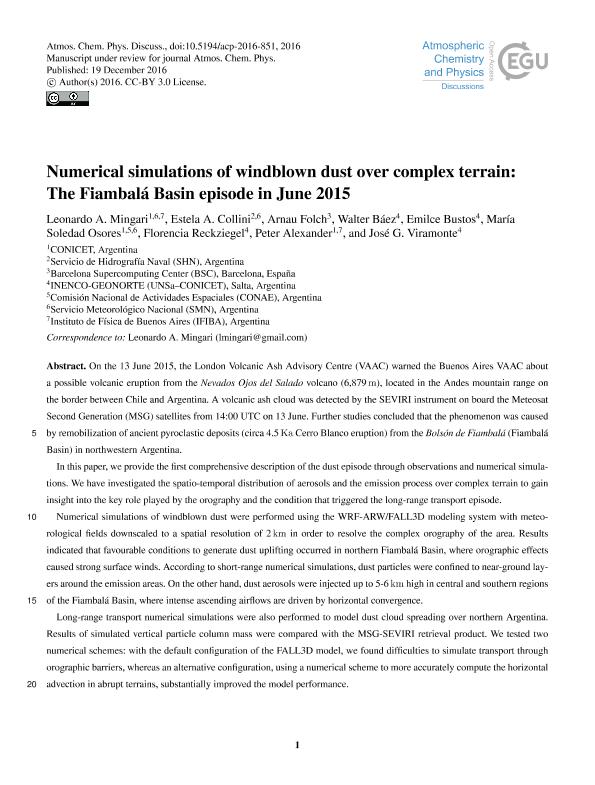Artículo
Numerical simulations of windblown dust over complex terrain: the Fiambalá Basin episode in June 2015
Mingari, Leonardo Alejandro ; Collini, Estela Angela; Folch Duran, Arnau; Baez, Walter Ariel
; Collini, Estela Angela; Folch Duran, Arnau; Baez, Walter Ariel ; Bustos, Emilce
; Bustos, Emilce ; Osores, María Soledad
; Osores, María Soledad ; Reckziegel, Florencia Mabel
; Reckziegel, Florencia Mabel ; Alexander, Pedro Manfredo
; Alexander, Pedro Manfredo ; Viramonte, Jose German
; Viramonte, Jose German
 ; Collini, Estela Angela; Folch Duran, Arnau; Baez, Walter Ariel
; Collini, Estela Angela; Folch Duran, Arnau; Baez, Walter Ariel ; Bustos, Emilce
; Bustos, Emilce ; Osores, María Soledad
; Osores, María Soledad ; Reckziegel, Florencia Mabel
; Reckziegel, Florencia Mabel ; Alexander, Pedro Manfredo
; Alexander, Pedro Manfredo ; Viramonte, Jose German
; Viramonte, Jose German
Fecha de publicación:
12/2016
Editorial:
Copernicus Publications
Revista:
Atmospheric Chemistry and Physics Discussions
ISSN:
1680-7375
Idioma:
Inglés
Tipo de recurso:
Artículo publicado
Clasificación temática:
Resumen
On the 13 June 2015, the London Volcanic Ash Advisory Centre (VAAC) warned the Buenos Aires VAAC abouta possible volcanic eruption from the Nevados Ojos del Salado volcano (6,879m), located in the Andes mountain range onthe border between Chile and Argentina. A volcanic ash cloud was detected by the SEVIRI instrument on board the MeteosatSecond Generation (MSG) satellites from 14:00 UTC on 13 June. Further studies concluded that the phenomenon was causedby 5 remobilization of ancient pyroclastic deposits (circa 4.5Ka Cerro Blanco eruption) from the Bolsón de Fiambalá (FiambaláBasin) in northwestern Argentina.In this paper, we provide the first comprehensive description of the dust episode through observations and numerical simulations.We have investigated the spatio-temporal distribution of aerosols and the emission process over complex terrain to gaininsight into the key role played by the orography and the condition that triggered the long-range transport episode.10 Numerical simulations of windblown dust were performed using the WRF-ARW/FALL3D modeling system with meteorologicalfields downscaled to a spatial resolution of 2km in order to resolve the complex orography of the area. Resultsindicated that favourable conditions to generate dust uplifting occurred in northern Fiambalá Basin, where orographic effectscaused strong surface winds. According to short-range numerical simulations, dust particles were confined to near-ground layersaround the emission areas. On the other hand, dust aerosols were injected up to 5-6km high in central and southern regions15 of the Fiambalá Basin, where intense ascending airflows are driven by horizontal convergence.Long-range transport numerical simulations were also performed to model dust cloud spreading over northern Argentina.Results of simulated vertical particle column mass were compared with the MSG-SEVIRI retrieval product. We tested twonumerical schemes: with the default configuration of the FALL3D model, we found difficulties to simulate transport throughorographic barriers, whereas an alternative configuration, using a numerical scheme to more accurately compute the horizontal20 advection in abrupt terrains, substantially improved the model performance.
Palabras clave:
Numerical Simulations
,
Resuspension Event
,
Fiambala Basin
Archivos asociados
Licencia
Identificadores
Colecciones
Articulos(INENCO)
Articulos de INST.DE INVEST.EN ENERGIA NO CONVENCIONAL
Articulos de INST.DE INVEST.EN ENERGIA NO CONVENCIONAL
Articulos(SEDE CENTRAL)
Articulos de SEDE CENTRAL
Articulos de SEDE CENTRAL
Citación
Mingari, Leonardo Alejandro; Collini, Estela Angela; Folch Duran, Arnau; Baez, Walter Ariel; Bustos, Emilce; et al.; Numerical simulations of windblown dust over complex terrain: the Fiambalá Basin episode in June 2015; Copernicus Publications; Atmospheric Chemistry and Physics Discussions; 17; 12-2016; 6759-6778
Compartir
Altmétricas



